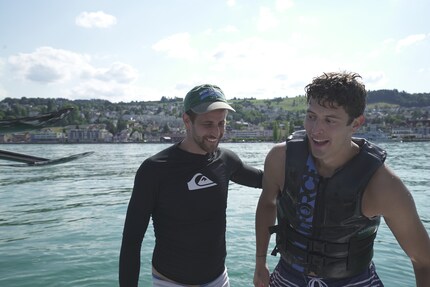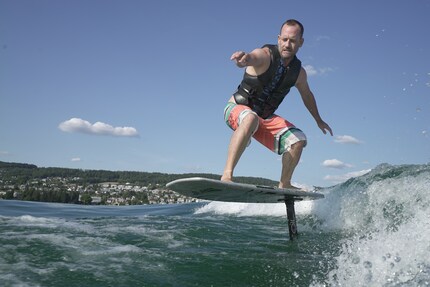
Across Lake Zurich on a wakefoil
Four letters are currently the talk of the surfing scene: foil. Whether surfer, kiter or wakesurfer - foiling is on almost everyone's lips. Time for us to try it out for ourselves on Lake Zurich.
Andreas Kundert and Michael Rudin work as Senior Project Manager and Product Owner respectively at Digitec Galaxus. The two experienced hobby surfers are venturing onto a wakefoil for the first time today. In very simple terms, a "foil" is a kind of wing or aerofoil under the board. This foil provides the necessary buoyancy and lifts the board out of the water.
Andreas Kundert:
Until a week before the test, I didn't realise that there was such a thing as "Hydro Foils" for wakesurfers. I only knew about foils from the "Americas Cup" sailing regatta - and from the hydrofoil in Locarno. I thought it was extremely cool as a child and as a former competitive sailor, I was later fascinated by the huge racing catamarans in the last Americas Cup regattas.
After I was asked to take part in the test, the first thing I did was watch a few YouTube videos. I just thought "How difficult can it be?". As a fairly experienced wakesurfer and former hurdle sprinter, I'm sure I'll be fine with surfing and coordination on the board. I didn't overhear the advice to wear a slightly thicker life jacket and a helmet at the beginning.
Michael Rudin:
When I first watched one of those cool "How to Wakefoil" videos, I couldn't wait to try out this new surfing tool. After the first instagrammable pictures, the speaker explained the risks we have to deal with. "Wear a helmet - you probably going to fall on the foil on your first attempts". That sounded promising, so Andi and I ventured into the water with a wakefoil for the first time.

All beginnings are difficult
Andreas:
Out on the lake, the first thing I dare to do is get into the water. After all, I'm prepared, having watched what feels like a dozen YouTube videos. Once in the water, however, I quickly realise that it's not like surfing. The weight of the foil, which is far down, immediately places the board vertically on the water. You can simply turn the wakesurf board sideways with a bit of heel pressure, push against the pressure of the boat and stand up. You can't do that with the foil, you have to do it by hand. So I try more or less to put the board crossways with my left hand and hold the cord for the pull with my right hand. I have to ignore the stupid comments from the boat that it will soon be dark if I keep going so slowly and concentrate on the board. Then the boat sets off - as fast as I'm used to from wakesurfing - and I'm in the water for the first time. Many more times will follow.
Michael:
You notice the additional weight of the foil straight away. The board feels heavier and more sluggish overall than a normal wakeboard. When launching, it is important that you keep the wakefoil parallel to the surface of the water. You need to hold the starting line with your right hand and stabilise the board with your left hand. As soon as the boat starts and you feel the resistance, you can grab the line with both hands and slowly straighten up. It is important to straighten the board slowly, as the foil needs a certain amount of time to build up buoyancy. You should also surf outside of the boat wave first, as there are fewer water eddies and the board can be kept calmer.
Right fall
The most important thing for foil beginners is to fall correctly. It is an advantage that you don't hit the foil when you fall, as the edges are quite hard. It can therefore make sense to wear a helmet. However, the most important basic rules are as follows:
- Do not actively try to push yourself off the foil. You only risk it turning with the wings.
- Just stay on the foil and let yourself fall into the water with the board
- Avoid bending your upper body sideways and tilting the foil at the same time.
The waistcoat and helmet thing
Andreas:
At the beginning I mentioned the YouTube video in which you are advised to wear a waistcoat and helmet. Well, you should definitely wear a waistcoat when wakesurfing anyway. The helmet should at least be worn when wakeboarding at high speeds. I actually came into contact with the foil twice when I crashed. That hurts like hell. Similar to a "thigh tomate" in football, only on a very small area. Unlike a normal board, the foil just keeps going when you fall. That's why it's important that you try not to jump off, but instead slowly put yourself down or simply wait until you and your board are in the water. When you jump, the foil gets a different angle and then goes somewhere - for example into your own calf. But it's definitely not dangerous. The many crashes Michael and I had that afternoon didn't result in anything serious.

Our conclusion
The Indiana Foil is a great thing. Despite initial difficulties with the new surfing feeling and the many falls, I would definitely recommend every wakesurfer to give foiling a try. You need a bit of patience, but if you think back to your first wakesurfing lesson, it certainly wasn't easy at first either. Once you've internalised the new feeling, it feels great. I will definitely try to keep at it.
Michael:
After this afternoon, we wouldn't call ourselves "wakefoil experts" yet. However, we are enthusiastic about this new way of wakesurfing. Although it's not easy, you get an amazing feeling when the foil comes out of the water for the first time and you glide across the lake with virtually no resistance. We recommend the Wakefoil to any ambitious and sporty wakesurfer looking for their next challenge. Don't give up so quickly and try it out many times in a row, especially at the beginning. Have fun and good waves!
The board and the foil

The entire Indiana range at Galaxus